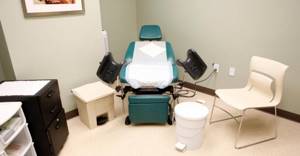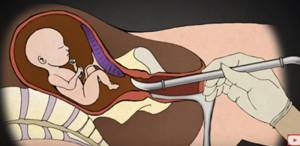Abortion is the only surgical intervention whose main goal is not considered to be getting rid of the disease. On the contrary, abortion is carried out in order to prevent a natural phenomenon. And no matter how long it is allowed to terminate a pregnancy, no matter what method is used for this, abortion extremely rarely does not have consequences for the woman’s health. The number of abortions in Russia increases every year. Women are often interested in why medical abortion is dangerous and is it dangerous at all? Let's try to figure it out.
Consequences
Women who have not yet given birth are interested in the dangers of abortion during their first pregnancy. And it’s not for nothing that they ask this question, because it is considered the most dangerous. The function of childbearing programmed by nature changes significantly. The body does not know how the cervix opens before the scheduled period, for what reason the fetus is removed using an incomprehensible method. In this regard, no matter how traumatic the intervention may be, the consequences of abortion will occur. After all, the operation encroaches on the most important function of any woman’s body – reproduction.
The very first danger of abortion in the early stages is the inability to have children in the future. Most infertile women were unable to give birth to children in the future precisely as a result of abortion. This could happen because complications arose during or after the procedure. An abortion, among other things, could result in injury to the internal genital organs. The possibility of infertility is more acceptable in women who become pregnant for the first time. According to statistics, half of the total number of episodes of tubal infertility is caused by termination of pregnancy.

How many abortions can you have?
This question is of interest to many women. Some, having had one abortion, fear that if they have a second abortion, they risk never getting pregnant again. There are no restrictions on this matter. The number of permissible abortions depends on the woman’s health, her physiological characteristics, and the type of abortion (by what method the fetus will be removed from the uterine cavity). The qualifications of the specialist who will perform the procedure are also important.
A woman herself must decide each time whether she needs to have an abortion or not. Every termination of pregnancy is a serious stress, both physical and psychological. The consequences for some women may be very minor, while for others an abortion can lead to infertility.
Even if not too dangerous methods are used (that is, not surgical), it is impossible to exclude hormonal imbalance. And if surgery is performed, perforation of the uterus is possible. Sometimes the bleeding is too severe to repair the damage. As a result, the uterus has to be removed completely, which leads to infertility.
Doctors believe that the question of how often it is possible to have abortions is not very correct. Doctors can only say one thing: abortion can be performed as often as the body allows. More precisely, how quickly the body manages to recover after pregnancy and abortion.
Any gynecologist will tell you how harmful abortion is for the health of a pregnant woman and will recommend weighing the pros and cons before performing this procedure. The issue should be considered not from the point of view of the frequency of abortion, but from the point of view of harm to the body. And here we can confidently say that every termination of pregnancy negatively affects a woman’s organs and her hormonal background. It is important to minimize the risk of complications, and this can only be done by the absence of abortions or a small number of them, the fewer the better.
Scraping
The most popular method of abortion is fetal curettage; even during the procedure, it can cause significant health problems. Is abortion dangerous after cesarean section, as well as during the first pregnancy? Such an abortion is performed almost blindly and by touch. Even a doctor with extensive experience often has to perform an operation almost at random, since the location of the internal organs and the fetus are not visible to him. The specialist will point instruments into the internal cavity in order to find, dismember and remove the fetus. During this process, many organs can be damaged. An unnatural opening of the uterus can result in injury to the uterus.
Indications
Based on the point above, you can determine the indications for abortion at 16 weeks. Among them are pregnancy from a rapist, ectopic pregnancy, serious complications of the mother’s health, and disorders in the development of the fetus. Usually, at such late stages as 16 weeks, an abortion is performed only after a special medical commission, which decides how appropriate, necessary and safe the operation is.

But the final decision is made by the patient herself. Without her consent, doctors have no right to medical intervention. It is possible only in case of a serious threat to a woman’s life, when help is needed immediately. So an abortion at 15-16 weeks is a rather difficult matter.
Consequences of scraping

Possible consequences after an abortion:
- Injuries to the vessels located in the uterus lead to large blood losses.
- Inflammation of the genital organs appears as a result of infection during surgery. If the uterine tubes become inflamed, then there is a possibility of an ectopic pregnancy subsequently, which is also fraught with abortion.
- The impossibility of a new pregnancy appears after an abortion due to the fact that obstruction of the uterine tubes may develop.
- Difficulties in subsequent pregnancy. Injuries to the cervix are fraught with deterioration of its condition, and this threatens miscarriages and premature birth.
- Menstrual irregularities. They arise due to injury to the uterine mucosa. The result is severe bleeding and pain during menstruation.

- Mental disorders. Women who decide to terminate a pregnancy often feel guilty, afraid, and depressed. They are characterized by mood swings, unreasonable hysterics, and nervousness. This may be considered the result of impaired functioning of internal organs, abnormal heartbeat, etc.
Gynecologist: “I don’t know if the women who cried... before the abortion have forgiven me”
Boleslaw Piecha, Vice Minister of Health of Poland (2005-2007).
Question: A new, conceived person “stays” in the mother’s body for only 9 months. But many women believe that since the womb is part of their body, they have every right to kill the child developing in it.
Boleslav Piekha: This is a serious ethical problem. Even pre-Christian peoples instinctively respected pregnancy. The woman was protected by a “taboo”; she could not be approached, because those around her felt that the state she was in was special. Today, doctors have scientifically proven that the moment a new life arises is the meeting of a sperm and an egg cell, that is, fertilization that occurs during sexual intercourse. This is a real miracle of nature. And each time this is the appearance to the world of a new personality, with his own unique genetic code, with his own abilities and talents, which are reflected throughout life. Many psychologists argue that already in the prenatal period of development a child is sensitive to all kinds of stimuli, the influence of which on the body is inevitable. Nowadays it is no longer believed that a person after birth is like a tabula rasa (Latin for “blank slate”). Just a few decades ago it was thought that a child born at 28-30 weeks of pregnancy was not viable. Currently, the period that is considered non-critical for the survival of a premature baby is constantly increasing. Every person and gynecologists, regardless of worldview, has an internal moral law and knows that he does not have the right to violate certain norms, in particular, to interfere with a conceived life.
Question: However, in the past, gynecologists often had to act against their conscience when performing abortions.
Boleslav Piekha: I graduated from the institute in 1981, and then worked as a doctor for almost 20 years. I studied where there was no place for ideological discussions. In order to perform abortions, it is necessary to deprive future doctors of humanity, to wean them from sympathy for a person whom you cannot see for the sole reason that he is hidden in the womb (we could not observe him there then, since the ultrasound method appeared later). However, gynecologists have seen the results of numerous abortions.
Question: What were the guidelines for gynecologists then?
Boleslav Piekha: The law that was in force at that time spoke about the conditions when abortion was permissible. There were many of them. One of the most significant conditions was considered to be the difficult financial situation in which the woman found herself. In order to have an abortion without hesitation, a whole system was developed at that time. Both doctors and mothers were taught that a child in the womb was not yet human. In order to disorient people as effectively as possible, instead of the word “child”, lexemes such as “tissue”, “trophoblast”, “zygote”, “fetus”, “embryo” were used. And we did this purposefully, since these words did not carry an emotional charge, and, therefore, their use did not give rise to a negative ethical assessment. The mother was “processed” in the same way: she was told not that she was “terminating the pregnancy by killing the child,” but that she was agreeing to “removal of tissue, fetus, etc.”
Question: When did you (gynecologists) start calling a spade a spade?
Boleslav Piekha: The concept of a “conceived child” began to appear in the mid-1980s, when society became bolder in the wake of the Solidarity movement. I then collaborated with psychologists involved in pro-life organizations. The first film I was invited to watch shocked me and my colleagues. This was in 1984, I then worked in the gynecology department in the city of Rybnik, where four and a half thousand children were born at that time, and there were thousands of abortions. The pro-life community then organized for us - three gynecologists - a closed viewing at the Rybnitsa church. Gynecologists watched Nathanson's The Silent Scream.
Question: Do you remember what the reaction was to the image of a child being killed?
Boleslav Piekha: I remember. Actually, each of us imagined it exactly as it was shown in the film. But then we had carefully laid down mechanisms for repressing the unpleasant truth, and we tried not to think about it. And the film showed that what we preferred not to think about can be illustrated and that here they are, the bare facts. After watching the film there was silence. The gynecologists were confused. The pro-life activists in the audience treated us very civilly. There were no accusations against gynecologists. And this is precisely what, apparently, shocked us then most of all and freed our conscience. These tactful pro-life activists later helped shape me the way they help a child...
Question: How was the abortion performed?
Boleslav Piekha: I have already mentioned the necessary mechanism for this to repress the truth into the subconscious. It was like a double misfortune. I constantly felt that something was wrong here, and since I was raised in a Catholic family, I felt it doubly. And these remorse needed to be somehow drowned out.
Question: Have you and other gynecologists seen the arms and legs of unborn children?
Boleslav Piekha: Of course, I saw it. It was not some kind of mass, a membrane after curettage of the uterus... Every gynecologist who took part in the abortion saw parts of the child’s body. I had to pretend to be an insensitive guy and be unshakable, even aggressive. This was a necessary method of self-defense. The conversations I then had with women seeking abortions were immoral, and today I would judge my past behavior as disgraceful. I tried to shift my blame onto the woman, letting her understand that, as a gynecologist, because of her I was forced to do work that I did not need.
Question: Maybe you advised them not to have an abortion?
Boleslav Piekha: This was out of the question, because then I would have contradicted myself. My task was to shift the blame onto her, to believe that she was to blame for everything, and not I, the doctor. I was angry with the woman who came with her problem. She did not know how to speak out, but no one tried to give her such an opportunity. Sometimes she cried, and this only increased her anger. We didn't let her make excuses. “If she came, it was only to cause problems for me” - this version was the best, because at some point it shifted the blame onto someone else. As a result, neither questions about the meaning of life nor friendly conversation seemed necessary. But in fact, the decision to have an abortion is always a consequence of the fact that a woman finds herself in a trap, without support and help.
Question: Do doctors experience post-abortion syndrome after such operations?
Boleslav Piekha: At the moment it is known that it affects not only women. Until now, textbooks have mentioned it only in connection with a woman’s condition. But there are known descriptions of the behavior of killers of innocent people since the Second World War. We can conclude that this did not pass without a trace for them; moreover, it led to psychological trauma. I also felt bad. I got irritated when someone talked about abortion, and ridiculed it all - yes, even such monstrous situations happened. In life, I looked for release in companies and at parties. I had to somehow drown out everything within myself. I was very aggressive, and towards my subordinates too. If a nurse didn’t want to assist me, he would shout at her and threaten her with dismissal.
Question: And you fired?
Boleslav Piekha: This didn’t happen, but aggression accompanied us. The gynecologists were on edge.
Question: Did this affect women during childbirth?
Boleslav Piekha: I was an obstetrician-gynecologist by vocation. For four years I had these unfortunate abortions and at the same time delivered babies. I was like Dr. Jekyll and Mr. Hyde. It was only after watching The Silent Scream that I felt total discomfort. I have received my sight. It was no longer possible to simply repress the fact of the murder into the subconscious - it was necessary to take some kind of sedative. There was more alcohol... I had to diagnose myself. Of course, this happened gradually; I did not immediately become a “convert.” But he began to avoid abortions.
Question: Was this possible?
Boleslav Piekha: It was difficult, but possible. Either I got sick, or I persuaded my gynecologist colleague to have an abortion... I hid like an irresponsible child.
Question: What could happen if you constantly refused to perform an abortion?
Boleslav Piekha: I would have simply been fired. Luckily, my primary doctor also saw the movie The Silent Scream. He also changed his mind and stopped forcing us to have an abortion. But after a whole year of such tricks, a final explanation had to be made. And one day I told my boss that I would no longer perform abortions at all. He understood me and I shouldn't have killed anymore, but not everything became OK instantly. I became involved with the pro-life movement. He began referring women who intended to kill their children to psychological counseling. This was to give them time to think. If a woman refused an abortion, she could count on help from the Catholic Church.
Question: How did you get rid of post-abortion syndrome?
Boleslav Piekha: Any revival from moral ashes is difficult. It took me about a year. First, I had to be ready to talk about what I had done. Secondly, I had to admit: “I was the one who performed the abortions.”
Question: Have you forgiven yourself for this?
Boleslav Piekha: I prefer not to answer such a question... I don’t know. I’m already able to talk about it, I don’t hide my past and, of course, I’m not proud of it. I've come to understand that I shouldn't be too quick to judge anyone. It's my fault too. I don’t know if those women who cried in my office before the abortion forgave me. Will they remember me for the rest of their lives? Maybe they came in the hope that I would tell them the one word that would keep them from having an abortion. Among hundreds of cases, this situation must have occurred.
Question: Now you protect life. What is the most important thing in this activity?
Boleslav Piekha: Educating and convincing people that they are not dealing with “tissue” in “my uterus,” but with a specific person.
Question: What should you do if pregnancy threatens the mother’s life?
Boleslav Piekha: Such cases are an insignificant percentage. I myself have not terminated a single pregnancy since that time, although there have been hopeless cases. I remember a woman who in 1989 had metastatic cancer of the digestive tract. She was told that she would die if she did not have an abortion. I knew that in any case - whether the pregnancy continues or is terminated - this will not affect the woman’s health in any way. A month before giving birth, I experienced a shock when I felt a tumor near her uterus. I was present at the birth of this woman's healthy child and at her death. I felt it was my duty because we gave birth together. It was heroism, although she didn't feel it. She died out calmly and had no complaints against anyone. I don’t know if she would have felt the same way if she were dying with such a sin on her soul?
Question: You talked about the terrible sensations that accompany the sight of aborted children. How do you feel when you see a newborn baby?
Boleslav Piekha: This is the most beautiful moment for me. All these efforts during childbirth, aimed at overcoming the woman’s stress (and her own anxiety) ... And then - the sight of a new person.
Source: Newspaper “Guest Nedelny” (“Sunday Guest”) No. 27/2007
Translation by Pavel Byzov
Who's at risk?
Disastrous abortion results are not uncommon. But there is a special risk group that is more at risk after surgery than others:
- Women who have had two or more abortions.
- Women with inflammation of the reproductive system.
- Women who had an abortion during their first pregnancy.
- Women who have had surgery on the ovaries or uterus.
The most frightening result of an abortion is a decrease in the ability to bear a normal child without diseases in the future. Abortion increases the possibility of an ectopic pregnancy, defects of the placenta and the unborn child. After the first termination of pregnancy, the possibility of losing the child is a quarter of all situations; a second abortion increases this number to one third. All of the following operations not only increase the chance of miscarriage to 50%, but also pose a threat of developing tumors of the breast, uterus and cervix.

Indications for abortion
Short term abortions are often carried out at the request of the woman herself. However, there are also so-called indications for termination of pregnancy. They are usually divided into medical and social. The first include diseases that are incompatible with the life of the fetus - a miscarriage occurs, the child is born with anomalies and defects. An abortion can be prescribed for medical reasons when the pregnancy process itself is undesirable for the woman’s body - tumors in the pelvis, recent miscarriage.
Social indications are usually called those reasons that are determined both by the health of the mother and her living conditions - dysfunctional families, the presence of genetic diseases in the family. In such cases, the decision to perform an abortion is made by a medical commission. At the same time, the desire of the woman herself is also taken into account. The list of indications for termination of pregnancy for social reasons is different for different countries, and is determined in the order of the Ministry of Health.
Termination of pregnancy for medical reasons
Termination of pregnancy by vacuum aspiration is also carried out for medical reasons. These are indicated in the regulatory documents of the Ministry of Health. If a woman is diagnosed with a pathology or is unable to bear a baby, a date for the operation is set. The choice of technique depends on the gestational age and the presence of concomitant pathologies. Common medical indications for which abortion is performed include:
- active stage of tuberculosis;
- rubella – contact with a sick person before 12 weeks of pregnancy, lack of immunity;
- pelvic tumors, the treatment of which involves the use of x-rays;
- severe diabetes mellitus (with kidney damage);
- acute leukemia;
- severe mental disorders;
- addiction;
- meningitis, encephalitis;
- epilepsy with a predisposition to frequent seizures;
- heart defects;
- stomach ulcer with bleeding;
- hepatitis and cirrhosis;
- glomerulonephritis.
Termination of pregnancy for social reasons
If there are such indications, abortion with pills is carried out in a hospital setting. The list of social indications may differ and depend on the country of residence of the pregnant woman. So in the CIS countries, the main social indications for which abortion is performed are:
- husband's disability (group 1, 2);
- death of a breadwinner during pregnancy;
- stay of a pregnant woman or her spouse in places of deprivation of liberty; a court decision on deprivation of parental rights;
- divorce during current pregnancy;
- having refugee status;
- lack of own housing;
- low family income (less than the subsistence level).

Why is abortion especially dangerous for a woman who has not given birth?
The statistics are quite deplorable: 80 out of 100 women diagnosed with infertility had an abortion when carrying a child for the first time.
- “Primary miscarriage” means that the body has retained in “memory” everything that happened during the first pregnancy and subsequently tries to repeat everything.
- Inability to bear a child. The uterine cervix, which is first opened through surgery, loses its good condition and flexibility, which affects the woman’s ability to give birth to a healthy child.
- Problems with menstruation. The first termination of pregnancy can interrupt the normal functioning of the endocrine system. Hormonal levels will deviate from normal levels. Critical days become irregular. Hormonal changes also affect a woman’s psyche and can lead to problems with excess weight and sexual deviations.
- Possible damage to the walls of the uterus, infection (both during the first abortion and subsequent ones).
To make the first termination of pregnancy less traumatic and reduce all possible negative results from the procedure, you need to resort to medical or vacuum abortion. Since surgical termination of the first pregnancy is almost always very dangerous.

Surgical abortion
This type of abortion is extremely responsible, because the doctor directly penetrates into the “holy of holies” - the female uterus, and he must do this extremely carefully and carefully.
In this case, the fetus is pulled out mechanically, dilating the cervix. In girls who have never given birth, the cervix is not wide, and therefore the doctor will be forced to prescribe medications, for example, lubricants, which will swell overnight and expand the walls of the uterus.
So, with a vacuum abortion, the fetus is sucked out of the uterus. Abortion is performed under anesthesia, and this method is the most gentle among all surgical ones. And if your pregnancy is from nine to twenty-two weeks, then we can talk about curettage. To do this, the doctor divides the fetus into parts so that it can be pulled out. An abortion is performed using anesthesia, so you will not feel anything during the operation.
Is abortion with the pill dangerous?
If the timing and time permits, then it is better to terminate the pregnancy with the help of medications. As stated earlier, this will reduce the danger of negative impacts and negative outcomes of abortion. A second surgical abortion is even more dangerous than the first. Regardless of the total number of pregnancy terminations, the greater their number, the more the woman’s own health is undermined. In this regard, if it was not possible to carry out the procedure before the seventh week of pregnancy, it is not recommended to do it at all.
Abortion: different for everyone
The main criterion that should be taken into account when answering the question of how often an abortion can be performed is the recovery period of the woman’s body. And this period depends on health. Some doctors believe that six abortions can be performed in a year. This means that the body must recover in two months. This indicator is strictly individual. If the body recovers, for example, in four months, then the number of possible abortions per year is three.
In addition to the individual characteristics of the female body, external circumstances are also important. So, for the same woman in different periods, the recovery time may differ. This depends on the well-being of the pregnant woman, as well as her age. So, if after the first abortion a woman recovered for three months, the next time recovery may take six months. The woman herself can determine the approximate recovery time, focusing on her well-being. PMS disappears, mood and menstrual cycle normalize, depression goes away.
To find out for sure whether the body has recovered, medical confirmation is needed, including the concentration of hormones in the blood. The body will be completely ready for a new abortion when the levels of FSH (follicle-stimulating hormone) and LH (luteinizing hormone) are normal.
Some women have eight abortions and then give birth to healthy children. And some, after one abortion, can no longer have children. Therefore, you should understand: when you go for an abortion, you risk infertility. Moreover, no examination can guarantee 100% that the termination of pregnancy will be normal.
But infertility is not the worst thing that termination of pregnancy can lead to. Thus, too frequent abortions cause the development of estrogen-dependent tumors (uterine fibroids, endometrial hyperplasia, breast cancer and others) up to 40-45 years.
Adolescence
Today, statistics say that more than seventy percent of teenagers who become pregnant solve the problem through abortion. And this is very regrettable, because surgical intervention at such a young age can be fraught with many problems, even death for the girl. How dangerous is abortion (vacuum, medication, etc.) at this age?
With such early terminations of pregnancy, girls, without realizing it, can ruin their lives. It is logical that few girls want to complicate their fate at 16 years old, but an abortion at this age can be fraught with dangerous side effects, such as endometritis, inflammation, etc.

Abortions during adolescence are especially dangerous. Many people mistakenly believe that by solving the problem of unwanted pregnancy through medication, the girl will in no way harm herself. This is not so, because during medical termination of pregnancy, powerful hormonal drugs are used in large quantities, which can so shake the hormonal system that the girl will need to put it in order for quite a long time. No specialist can guarantee that everything will return to normal and the girl will have the opportunity to conceive and give birth to a child in the future.
Recovery after abortion
This phrase means that the normal functioning of all systems of the body must be established, the functioning of the mechanisms of neuroendocrine regulation must be established. This sometimes takes up to six months. The minimum acceptable period at which a pregnancy can be terminated again is three months. And even in this case, there must be medical evidence that an abortion can be performed.
If abortions are performed frequently, this will lead to the accumulation of functional disorders in the body. When the body is not restored, all functions in it do not work at full strength, and accordingly, they cannot normally protect the body from harmful influences. If the second abortion is performed earlier than three months later, then the disorders caused by both abortions are summed up, which can lead to the appearance of anatomical disorders, that is, there is a risk of a serious illness.
Is abortion really safe?
Possible complications after drug interruption are less likely than after surgery. In this case, what is the danger of pills? If there is heavy bleeding or significant hormonal problems, then in the absence of proper medical intervention, they can cause the inability to become pregnant and can even cause the death of a woman. Although medical termination of pregnancy is usually considered a traditional method, it can lead to significant hormonal disruptions. The main women's difficulties after this can be called:
- Spasms and severe uncontrollable blood loss.
- Inflammation in the reproductive system.
- Menstrual problems.
- Hyperthermia.
- Ovarian dysfunction.
- Pain in the abdominal cavity.
Medical abortion
Medical abortion is the taking of special medications that should only be prescribed by a doctor.
At the clinic, the patient takes the required dose of medication, and then remains in the clinic for some time. If there are no complications or side effects, then the gynecologist sends her home. Bleeding can last up to two weeks, after which the woman should return to the doctor. This type of abortion is unpleasant because it may be accompanied by cramps in the lower abdomen. After all, bleeding is an integral part of an abortion, when the fertilized egg comes out along with the blood.
Use of medications
Many women want to understand whether a mini-abortion is dangerous and how the rehabilitation after it goes. Soreness and bleeding immediately after a medical abortion are considered normal. The pain increases approximately 30-60 minutes after using Misoprostol, but after separation and release of the fertilized egg, it disappears. To reduce pain, you can take Naproxen or Ibuprofen, and if the pain is unbearable, narcotic painkillers such as Oxycodone or Codeine are sometimes prescribed.
In approximately three to four percent of cases, a pharmacological abortion can result in partial interruption or further development of the fetus and continuation of pregnancy. These kinds of effects after taking medication often occur when the dosage of the drugs is not observed or in late periods of pregnancy, the presence of hidden inflammatory processes or improper functioning of the hormonal environment. With similar results of an abortion, the woman is worried about prolonged, non-stop and heavy bleeding, which is accompanied by cramping, painful contractions, and a fever begins. To get rid of symptoms, as a rule, curettage of the fetus from the internal cavity is prescribed. If this is not done, the fetal tissue remaining inside will rot, provoke infectious processes, general blood poisoning, and even death is possible.
Restorative procedures after an abortion include the prevention of inflammatory processes, for which antibiotics are prescribed. To normalize hormonal status, doctors prescribe oral contraceptives. In general terms, after termination of pregnancy, especially at a long term, medications such as Doxycycline and Metronidazole, Fluconazole, which have an anti-inflammatory effect, vitamin complexes and various oral contraceptives are used.
Preparing for an abortion
Depending on the stage of pregnancy, you may be offered a completely different approach to preparing an artificial termination of pregnancy.
If we are talking about the early stages of pregnancy, the doctor will offer you a medical abortion, which is the most effective. A mini-abortion is performed at seven weeks. During a medical abortion, you need to prepare in a special way, since drugs are involved. Before this procedure, you should have a light breakfast so that the medications are better absorbed.
Towards a mini-abortion
you need to prepare more carefully. The patient must be tested for HIV, syphilis, hepatitis, and blood clotting. This is necessary because this method of interruption is a surgical procedure and requires more careful testing.
Features of a surgical abortion: you need to epilate your intimate parts, wash your face before lying on the couch, and remove any possible belly piercings. The doctor will do the internal treatment himself.
The operation will necessarily take place under anesthesia, and in this case it is painless. But what you need to remember is that if you eat before surgery, then all the contents of your stomach will be released into the respiratory tract, and this may end up unpleasant. Therefore, to avoid this, do not take anything before surgery, not even chewing gum.
How is an abortion performed?
At the moment, for a period of 4-5 months, three types of abortion are used in Russia: dilation and evacuation, dilation and curettage, and minor caesarean section. Medical abortion at this stage may be ineffective and cause complications. The most commonly used method is dilation and curettage, although this is not the safest method. To begin with, special preparations are used to expand the cervical canal. Then, using a curette (surgical spoon), the embryo is removed.

The danger of this method lies in the fact that doctors exert a very strong mechanical influence on the patient’s body; such a shock can cause profuse atonic bleeding, which is extremely unsafe. Curettage is recommended to be used only in extreme cases when other methods are inappropriate. Dilatation and evacuation is carried out in almost the same way as curettage, but instead of a curette, a vacuum aspirator is used to remove the embryo and amniotic fluid. This method is considered the safest of the above, as it is less traumatic. Hysterotomy, or minor caesarean section, is performed only in cases where the use of other methods is impossible for medical reasons, for example, in the case of mutations or fetal death, as well as in case of individual contraindications for the patient.
Consequences for the body
Abortion at 16 weeks is a very serious and risky operation. And the consequences after it may be different. This depends on many factors: the patient’s predisposition, the competence of doctors, compliance with sanitary standards during the operation, as well as the reasons for this operation. The only thing that all women experience after surgery is menstrual irregularities. It will take time to restore it and bring it back to normal, about 3-4 months, after which it will most likely level out. But there are also more serious consequences, such as acute bleeding, endometriosis and endometritis, uterine perforation and others. Often, after late abortions, women become infertile. All this is mostly individual and depends on many factors, but every woman is able to take care of herself and prevent complications by carefully and carefully restoring her body. After the operation, the patient usually continues to be under close medical supervision for 3-5 days. At discharge, the attending physician will tell you what the body needs now, and what you should avoid, and may prescribe some medications.
All doctor’s recommendations must be followed unquestioningly, as this will help speed up the recovery process. Moreover, it is necessary to maintain sexual rest until the menstrual cycle is completely restored. At first, you may experience some bloody discharge; during this period you should refrain from serious physical activity. A diet containing many vitamins and microelements will also be beneficial for a weakened body. Don’t forget to monitor your health: measure your blood pressure and temperature more often, and monitor the nature of your discharge. This is convenient to do in special applications for monitoring women's health.
Precautions to prevent the consequences of abortion
In order to minimize the consequences of an abortion, certain rules must be strictly followed. For the first time after an abortion, it is necessary to avoid any physical activity. Sexual activity is prohibited for a month after an abortion. During sexual contact, an infection can be introduced into the uterine cavity. To contract the uterus, it is very important to monitor the timely emptying of the bladder and intestines.
If you experience pain in the lower abdomen, bleeding or other unpleasant consequences of an abortion, you should consult a doctor.
Particular attention should be paid to genital hygiene. The genitals should be rinsed with warm water and a weak solution of potassium permanganate. Since the cervix remains slightly open, it is necessary to change your underwear as often as possible. For the first two to three weeks after an abortion, it is advisable to wash only in the shower. To prevent the consequences of an abortion, you should refrain from swimming in the river, sea, pool, as well as douching. If your menstrual cycle starts earlier or is delayed, you should consult a doctor.










